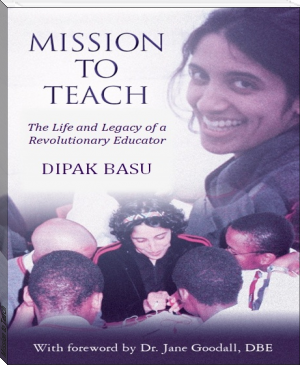Theories of intercultural education, Joseba Arregi, Asier Barandiaran, Dmitrii Enygin, Venera Midova [7 ebook reader .TXT] 📗

Book online «Theories of intercultural education, Joseba Arregi, Asier Barandiaran, Dmitrii Enygin, Venera Midova [7 ebook reader .TXT] 📗». Author Joseba Arregi, Asier Barandiaran, Dmitrii Enygin, Venera Midova
EuROpEAN JOuRNAL OF TEACHER EDuCATiON 391
goes in the other direction: it is through communication that culture is transmitted and continually reinterpreted.
unfortunately, the concept of culture, albeit indispensable, is frequently misunderstood and misused. Efforts to ‘take culture seriously’ too often end up in an exaggeration of the importance of culture: when confronted with the universalistic stance which ignores cul- ture, interculturalists are at risk of overreacting by way of a culturalist discourse, explaining everything in terms of cultural differences, reducing individuals to‘their culture’(as if belong- ing to a culture were self-evident, just as for some, belonging to a race would be). This is what Camilleri (1990) refers to as the sacralisation of cultures, which he considers the major pitfall of interculturalism : when culture is thought of as approaching the level of sacred, it fixes individuals in their immutable differences (hetero-attributed but also self-attributed). This overemphasis of culture may serve to hide power issues, with dominant but also dom- inated groups making use of the cultural argument, imposing a cultural definition of the situation, in order to maintain or gain power (Sarangi 1994; Wagener 2014). Gorski (2006) even denounces multicultural education programmes which are focused on the culture of the Other rather than on the struggle for social justice of being complicit with conservatism. To avoid culturalisation, Camilleri stresses the necessity of promoting a reflexive attitude that enables attachment to one’s cultural system without being bound to it and to maintain a position of ‘emersion rather than immersion’ (17). in his final paragraph, Camilleri captures the intricacies of interculturality:
There is a dialectical movement to work out in order to maintain the field of intercultural research and practice: assure the respect of cultures but in the context of a complex of attitudes author- izing their ability to go beyond themselves. provide partners with the necessary equipment to see their culture as legitimate and to access the fundamental feeling of being recognized and at the same time the liberty to take position, without making themselves guilty relative to the systems that surround them. All of this in order to eventually elaborate their individual cultural formula. This is one of the ways in which intercultural groups can become a matrix of intercultural creativity. (Camilleri 1990, 17)2
Of course, numerous scholars before us have criticised what Dervin (2011) calls a ‘solid’ understanding of culture. Some have even recommended the abandonment of the con- cept of culture all together (Abdallah-pretceille 2006; Abu-Lughod 1991). if we share these critiques, however, we cannot follow the recommendation to renounce the concept of cul- ture. We rather think that a misused concept should not be abandoned but re-defined and defended against inadequate uses. in our view, it is through the dialectical understanding of culture and interculturality, sketched out by Camilleri in the quoted citation above, that such excesses can be prevented.
3. A dialectical understanding of culture and interculturality
Being confronted with cultural diversity implies experiencing dialectical tensions: between sameness and difference, equality and diversity, universalism and relativism, continuity and change, openness and closeness (Demorgon 2005, 2015; Martin and Nakayama 1999). public policies such as multiculturalism and civic integration (Banting and Kymlicka 2013) reflect these tensions and are often thought to be incompatible. But tensions should not be thought of as contradictions to be resolved: the two competing elements of each pair are in a pos- itive and constructive tension: a dialectic, or a ‘dialogic’, according to the term preferred by
392 T. OGAY AND D. EDELMANN
Figure 1. dialectical square of cultural difference. Source: Edelmann 2007; adapted by ogay and Edelmann 2011.
Morin (1990, 99):‘The dialogic principle makes it possible to maintain duality in the heart of unity. it associates two terms that are at the same time complementary and antagonistic’.3 Such dialectical tensions are characteristic of postmodernity, described by Lyotard (1984).
He shows the growing variation of cultural orientations, lifestyles and worldviews. The post- modern age calls for the renunciation of a claim for a unique truth and instead leads to a permanent confrontation between a diversity of perspectives, value systems and lifestyles. Lyotard evaluates this as a positive development because postmodernity opens up a new space for ways of life and attitudes, provided that we are able to renounce the search for unity and clarity and the idea that contradictions can and should be eliminated.
For a proficient approach to cultural diversity, this means that it is neither about the foundation of unity nor the elimination of irresolvable contradictions of various types of discourses, but rather about developing skills and opportunities for navigating between the perception of sameness and difference. The important condition for this is, however, that teachers understand the inner logic of different types of discourses as well as their temporally limited validity and know how to integrate them accordingly into their professional activities (Gogolin and Krüger-potratz 2006). in summary, it can be stated that in dealing with cultural diversity, the confrontation with the contradictions between emphasis and non-emphasis of difference decisively shapes pedagogical activities. A reflexive approach to this ‘dialectic of difference’ is therefore a key element of educational professionalism in the transnational social space (Edelmann 2007). The dialectical square of cultural difference, inspired by the dialectical square of values by Helwig (1967) and Schulz von Thun (1997), illustrates the different and contradictory positions in the face of cultural difference (Figure 1).
The logic of the dialectical square of values by Helwig (1967) and Schulz von Thun (1997) is characterised by four premises: (a) a value orientation can unfold constructively only if it lies in a state of sustained tension with a positive counterpart (in the graphic, the upper horizontal connecting line); (b) an over-emphasis on a value leads to its exaggeration (in the graphic, the vertical connecting lines); (c) the lower horizontal line connecting the two devaluing exaggerations characterises the way ‘which we take when we want to avoid worth- lessness, but do not have the strength to work our way up to the required stress level of the upper plus value’ and hence ‘flee from worthlessness in one direction to worthlessness in another’4 (see Helwig 1967); (d) the diagonal connecting lines are developmental lines
EuROpEAN JOuRNAL OF TEACHER EDuCATiON 393
to follow for example in training sessions, leading from the exaggeration of a single value towards the positive dialectical tension between the two positive – even if opposing – values. Applied to cultural difference, the dialectical square of values posits that confrontation with cultural difference fosters a tension between the value of equality – recognising the equal worth and dignity of all humans – and the value of diversity – praising cultural differ- ences as enrichment. Equality and diversity, the two central values of intercultural education (uNESCO 2006), both have their darker sides (payet et al. 2011): too much of the value of equality alone, emphasising sameness only, results in indifference to cultural differences as well as to differences of social status and power, which leads to assimilationism and colour-blindness (Hachfeld et al. 2015; Lewis 2001). Teachers often adhere to this position of indifference to cultural difference (Allard 2006; Mahon 2006), and are proud to claim that they do not see any differences between their students and that they treat them absolutely in the same manner. in so doing, these teachers fail to see that they are not only negating students’ identities, but also that they are depriving themselves of the means to really under- stand their students as social beings. These teachers then contribute to the reproduction of social inequities, as has been denounced by Bourdieu (1966) in his critique of the appar- ently enlightened slogan of ‘indifference to difference’. As stated by Allard (2006), ‘treating everyone the same may not mean treating everyone fairly, since in many ways such notions of “sameness” negate material and/or embodied differences’ (326). However, diversity, the value that intercultural education has promoted in order to counter the universalist view of education, also has its darker side: too much of the value of diversity alone leads to cultural- isation, or sacralisation of cultures (Camilleri 1990) as mentioned earlier. As stated by Dietz, diversity has been transformed ‘from an analytic category to an imperative (...), turning to an ideology which politically and even legally promotes the perception of certain traits and features (...).’ (2007, 9). Considering the value of diversity alone leads to a solid conception of culture, which is then taken too seriously, returning to the words of Dervin (2011) and
Segall, Lonner, and Berry (1998).
The idea that interculturality elicits a tension between the values of equality and diver-
sity is of course not new (see in particular Allard 2006). But by revealing the underground layer of this tension, showing where the exaggeration of equality or diversity alone leads to, the dialectical square of cultural difference opens the way to a better understanding of the challenges of interculturality. Exaggerations, or ‘caricatures’ (Kymlicka 2012, 1), only lead to sterile debates. With the dialectical square of cultural difference in mind, professionals such as teachers, as well as teacher educators, may then realise that their own hesitations between equality and diversity are not problematic, and that a skilled handling of cultural difference does not mean pursuing equality or diversity, but both of them, even if these values are in opposition and involve apparently contradictory pedagogical actions. They might then appreciate the importance of the nuances in Camilleri’s definition of culture: ‘more or less linked’,‘most persistent’,‘most commonly’, which indicate that if it is possible to identify something such as culture, its borders are moving: what appears to be different may also be considered as similar (Brewer 1991). in particular, the dialectical square of cultural difference helps teachers to consider critically colour-blindness and its principle of equal- ity of treatment to which they frequently adhere. They become aware that indifference to difference results in the reproduction of social inequities and understand why they should rather strive for equality of the outcomes attained by their students. This latter principle of justice in education (Crahay 2000) implies nothing else than the positive dialectical tension
394 T. OGAY AND D. EDELMANN
between equality and diversity: the aim of equality as an outcome can be achieved only by taking into account the diversity between individuals and social groups. This is what differentiated pedagogy (Kahn 2010) is all about.
if teachers, social workers or health professionals are often reported to minimise cul- tural differences (Altshuler, Sussman, and Kachur 2003; DeJaeghere and Cao 2009; Mahon 2006), their intercultural trainers are at risk for culturalisation (like in the‘Teaching the Other’ approach described by Gorski in his analysis of uS multicultural teacher education pro- grammes, 2009). How to avoid the traps of culturalisation when teaching about culture? in the following section, we present three metaphors for the concept of culture that we have found useful to foster a complex and dynamic understanding of culture which makes it possible to take culture seriously without making it solid or sacred.
4. Three metaphors for a reasonable and dynamic understanding of culture and interculturality
4.1. Culture is like language
in her study of the development of intercultural competence through intercultural exchange programmes between teenagers from the French-and German-speaking regions of Switzerland, Ogay (2000) observed the reluctance of participants to talk about cultural differences, whereas these students at the same time declared to participate in an intercul- tural exchange. They were rightly concerned about the risk of culturalisation, which would threaten the unity of the federal state of Switzerland. The metaphor of culture as language, proposed by Barmeyer (2007) could have reassured them: stating that two groups speak different languages is usually considered as benign, as should be the observation that two groups refer





Comments (0)